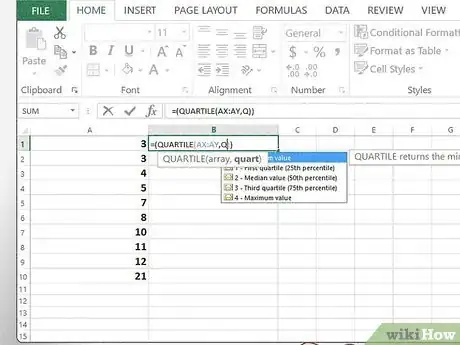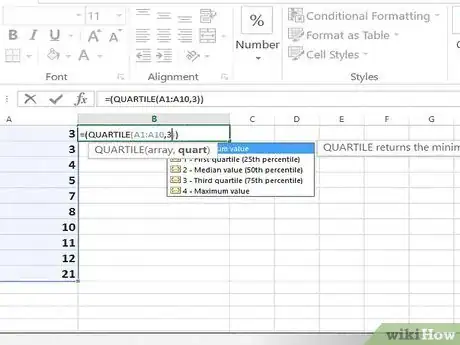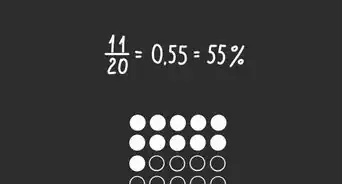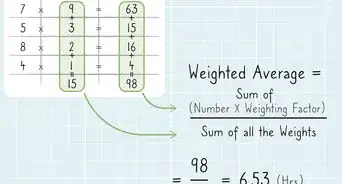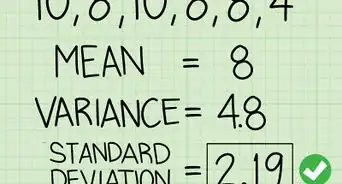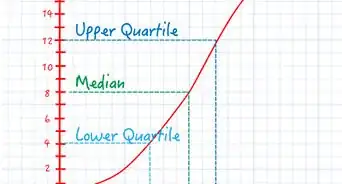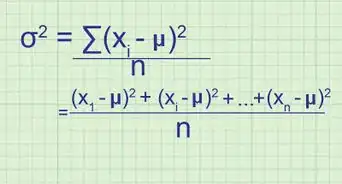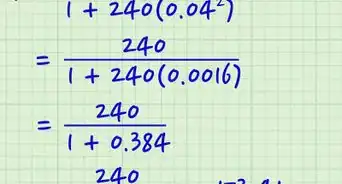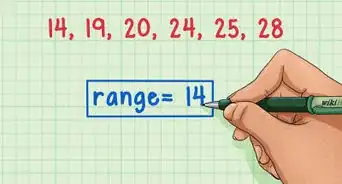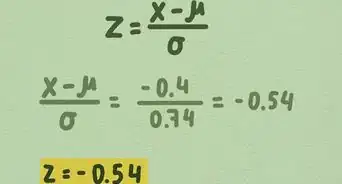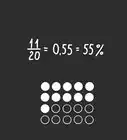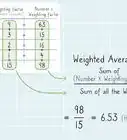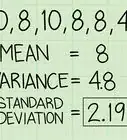This article was co-authored by wikiHow Staff. Our trained team of editors and researchers validate articles for accuracy and comprehensiveness. wikiHow's Content Management Team carefully monitors the work from our editorial staff to ensure that each article is backed by trusted research and meets our high quality standards.
This article has been viewed 146,981 times.
Learn more...
Quartiles are numbers used to divide a set of data into four equal parts, or quarters.[1] The upper quartile, or third quartile, is the top 25% of numbers in the data set, or the 75th percentile. The upper quartile is calculated by determining the median number in the upper half of a data set.[2] This value can be found by calculating with pen and paper, but you can also easily find the upper quartile using statistical software, such as MS Excel.
Steps
Data Set Prep
-
1Arrange the numbers of the data set in ascending order. This means ordering them from the smallest value to the largest value. Make sure to include all repeated values.[3]
- For example, if your set of numbers is [3, 4, 5, 11, 3, 12, 21, 10, 8, 7], you would reorder them like this: [3, 3, 4, 5, 7, 8, 10, 11, 12, 21].
-
2Determine how many numbers are in the data set. To do this, simply count each number in the set. Don’t forget to count each instance of a repeated value.
- For example, the set [3, 3, 4, 5, 7, 8, 10, 11, 12, 21] has 10 numbers.
Advertisement -
3Set up the formula for calculating the upper quartile. The formula is , where is the upper quartile, and is the number of numbers in the data set.[4]
Calculating the Upper Quartile
-
1Plug the value of into the formula. Remember that is the number of numbers in the data set.
- For example, if there are 10 numbers in your data set, your formula will look like this: .
-
2Complete the calculation in parentheses. According to the order of operations, you must attend to the parentheses first when evaluating a mathematical expression. In this instance, add 1 to the number of numbers in the data set.
- For example:
- For example:
-
3Multiply the sum by . You could also multiply by . This will show you the placement of the value in the data set that is at the three-fourths, or 75 percent mark, and thus the place where the data set is split into the upper quartile and the lower quartiles. This will not give you the number of the upper quartile.
- For example:
So, the upper quartile is given by the number at the position in the data set.
- For example:
-
4Determine the number representing the upper quartile. If you calculated a whole number, simply find that number in the data set.
- For example, if you calculated 12 using the formula, then the upper quartile is the 12th number in the data set.
-
5Calculate the upper quartile, if necessary. Usually, you will calculate a fraction or decimal using the formula. In this instance, find the value above and below this position in the data set, and find their mean, or average. To do this, divide the sum of the two values by 2. This will give you the upper quartile of your data set.
- For example, if you calculated using the formula, then the upper quartile is between the 8th and 9th number in the data set. In the set [3, 3, 4, 5, 7, 8, 10, 11, 12, 21], 11 and 12 are the 8th and 9th number. Calculate to find the average:
So, the upper quartile of the data set is 11.5
- For example, if you calculated using the formula, then the upper quartile is between the 8th and 9th number in the data set. In the set [3, 3, 4, 5, 7, 8, 10, 11, 12, 21], 11 and 12 are the 8th and 9th number. Calculate to find the average:
Using Excel
-
1Input your data into Excel. Enter each value into a separate cell. Don’t forget to include any repeated values. You can enter your data in any cells in the spreadsheet.
- For example, you might enter the data set [3, 3, 4, 5, 7, 8, 10, 11, 12, 21] into cells A1 through A10 in the spreadsheet.
-
2Enter the quartile function into another cell. The quartile function is =(QUARTILE(AX:AY, Q)), where AX and AY is the data range, and Q is the quartile.[5] Begin typing this function into Excel, then when it pops up in the menu, double-click on it to select.
-
3Select the cells containing the data. Select the first cell of the data range, then scroll down or across to select all the cells in the range.
-
4Enter 3 into the function to denote the upper quartile. Make sure you include a comma after the data range, and two closing parentheses.
- For example, if you want to find the upper quartile of cells A1 through A10, your function will look like this: =(QUARTILE(A1:A10, 3)).
-
5Show the upper quartile. To do this, hit enter after typing the function into Excel. This will show you the actual upper quartile, not the position of the quartile in the data set.
- Note that with the release of Office 2010, there are two different quartile functions: QUARTILE.EXC and QUARTILE.INC. These functions cannot be used in earlier versions of Excel, and QUARTILE can still be used.
- The two Excel quartile functions use a different formula to calculate the upper quartile. QUARTILE/QUARTILE.INC uses the formula , and the QUARTILE.EXC function uses the formula . Both formula are accepted ways to calculate quartiles, although the former is becoming standardized in statistical software.
Community Q&A
-
QuestionHow do you find the upper and lower quartiles?
 Community AnswerUse the methods above to find the upper quartile. To find the lower quartile using the formula, use Q1 = 1/4(n+ 1), or enter 1 into the Excel function instead of 3.
Community AnswerUse the methods above to find the upper quartile. To find the lower quartile using the formula, use Q1 = 1/4(n+ 1), or enter 1 into the Excel function instead of 3. -
QuestionHow do I determine the inter quartile range of data?
 Cluster DuckCommunity AnswerThe IQR can be calculated by subtracting the lower quartile from the upper.
Cluster DuckCommunity AnswerThe IQR can be calculated by subtracting the lower quartile from the upper. -
QuestionHow do I calculate the upper quartile for a large group of numbers?
 Community AnswerSame as for a small group of numbers. Or better use script language like Matlab or Python to load the dataset and do the calculations.
Community AnswerSame as for a small group of numbers. Or better use script language like Matlab or Python to load the dataset and do the calculations.
References
- ↑ https://www.mathsisfun.com/data/quartiles.html
- ↑ http://www.mathwords.com/t/third_quartile.htm
- ↑ https://www.mathsisfun.com/data/quartiles.html
- ↑ http://www.mathsteacher.com.au/year10/ch16_statistics/05_quartiles/24quartiles.htm
- ↑ https://support.office.com/en-us/article/QUARTILE-function-93cf8f62-60cd-4fdb-8a92-8451041e1a2a
About This Article
Quartiles are numbers used to divide a set of data into 4 equal parts or quarters. The upper quartile is the top 25 percent of numbers in the data set, or the 75th percentile. To calculate the upper quartile, first, arrange the numbers of the data set in ascending order. Then, determine how many numbers are in the set. The formula for calculating the upper quartile is Q3 = ¾ (n +1). Q3 is the upper quartile and n is the number of numbers in your data set. For example, if you have 10 numbers in your data set, you would solve Q3 = ¾ (10 + 1), then solve ¾ x 11, which would give you 8 ¼. If you get a fraction or decimal as your answer, the upper quartile will be the average of the number below and above in your data set. For example, if you calculate 8 ¼ for Q3 and the numbers below and above in your set are 8 and 10, the average of them is 9. Therefore, 9 is the upper quartile. To learn how to calculate an upper quartile in Excel, read on!





















